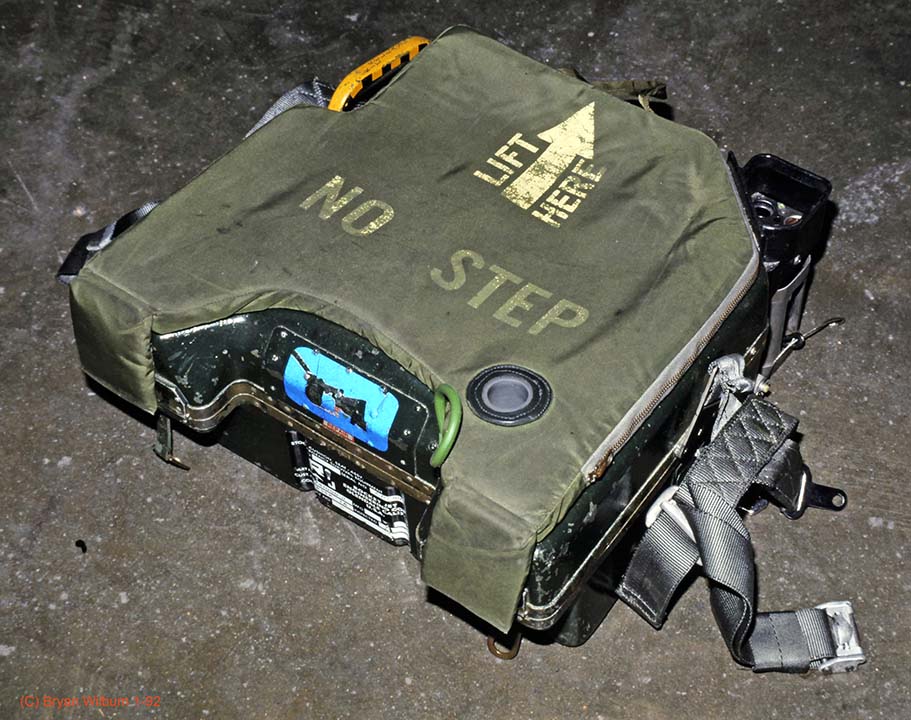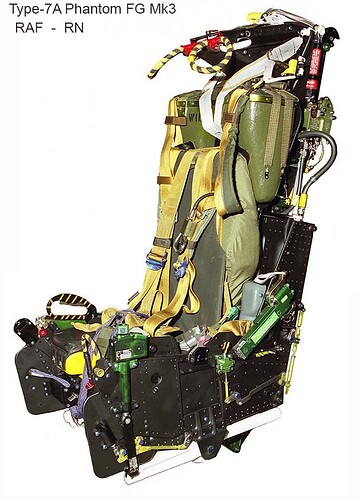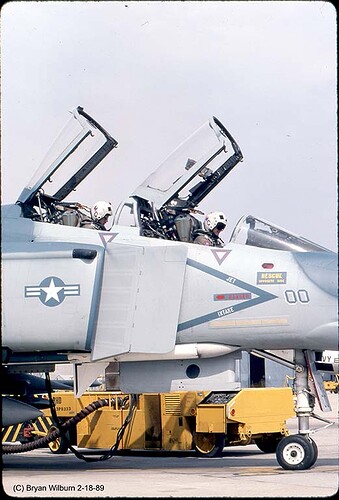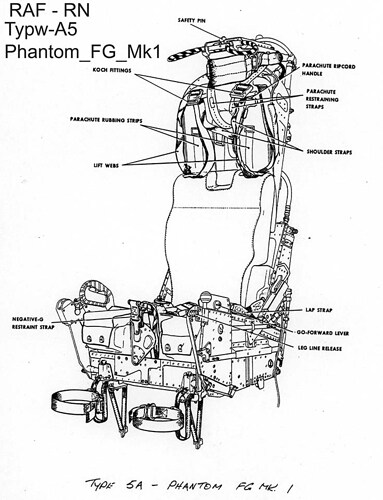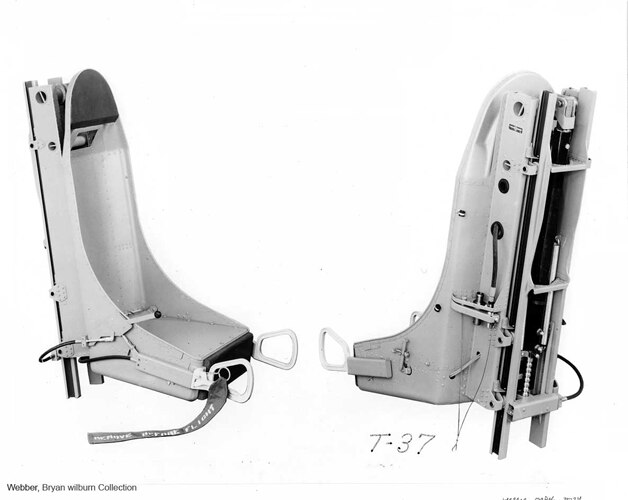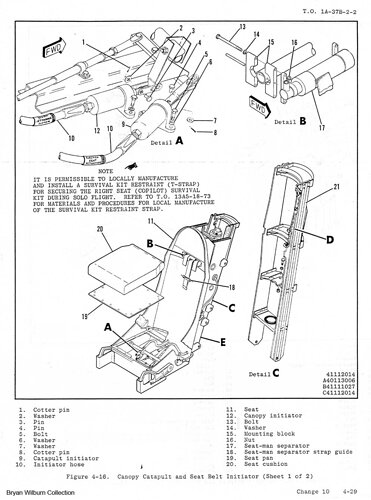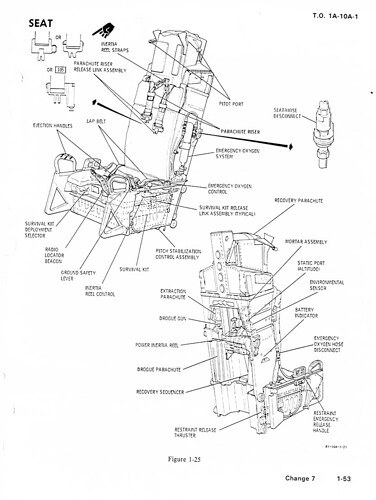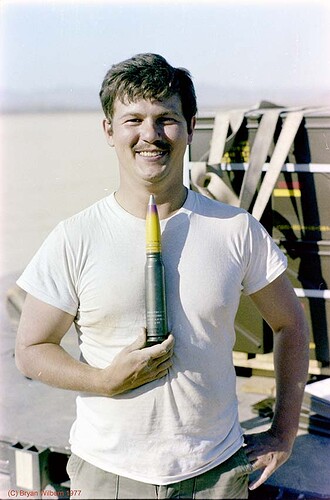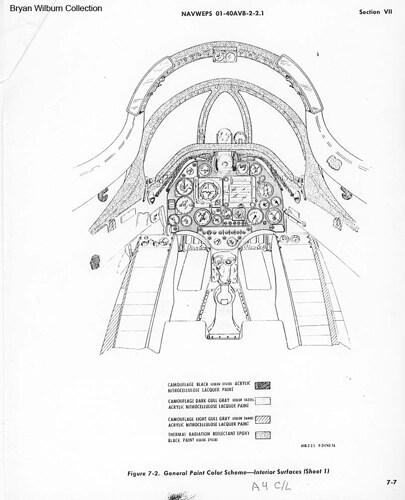All photos are mine except were identified. Information from USN/USAF and Martin baker tec Docs
We’ll start with the F4 Phantom ejection seats.
The first 10 USN F4H-1 airframes flew with McDonald/Stanley seats up till early 1963.
F4H-1 USN photo China lake
Mk-H5 seat, Photo MB
These were pulled in favor of Martin/Baker seats. The initial MB seats were Mk-H5 ballistic seats. Three charges fired in sequence to propelled the airmen out of the F-4 with about an 18G kick. Most crewmen that used a MB seat landed around ½” shorter than just before they pulled the firing handles. Back injuries were fairly common until a Vought crew station engineer named Adkins found out the reason was the “soft” seat pan/survival kit cushion. When the pilot pulled the handle and the seat started to go up, the crewman would actually start to go “down”, when he bottomed out he got a higher than 18G kick. With the hard seat pan, he went up with the seat and back injuries significantly decreased.
On 1 April 1968 the USN published Service Change AFC 307/Service bulletin No. 32SB471, “Emergency Escape System – Incorporation of Rocket Propulsion and Sequencing System”. (ECP-MDA-F-4-605) This was the conversion to rockets.
The seats were pulled, a rocket pack was put on the bottom of the seat pan, the “sugar scoop” (Backrest and Parachute Container Assembly) was removed (retained on the F-8) and the adjustable lumbar pad (if installed) was replaced with a hard case and a new nonadjustable backrest seat pad was installed.
To add interested, some Mk-H5 seats had the nonadjustable lumbar pad. This was changed to the nonadjustable after AFC 274 was incorporated into the seat.
The reason for incorporation of rockets into the seat was to arrest excessive sink rates, most likely encountered in the final stages of trapping on a carrier.
While there are other changes, these are the major ones that tell you if it’s a Mk-H5 or Mk-H7 seat. Aircraft in combat were likely upgraded first, over stateside units. And it is entirely likely that within a Squadron you had both seats for a time (in different airframes). Similar changes went into the F-8 at the same time.
Mk-H7 USMC F-4S circa 1991, note the “Standard Flight Suit” upper block.
Mk-H7AF RF-4C circa 1991
Mk-H7AF Chanute Tech Trainer circa 1990
In March of 1968 the USN was also modifying the Mk-5H seats to increase parachute opening altitude. So the Mk-5 seats stayed around for a number months if not years. I don’t have any information as to when the last Mk-5 was updated to a Mk-7.
Depending on the altitude of the flight some F-4 aircraft were flown by pilots in full pressure suits. This required the change out of Upper block Assembly. The Pressure suit units had the air and O2 lines that extended up to about 60% of the length of the overall assembly. The “Standard Suit” lines were about half as long. However, after AFC ACC 69 was applied and a much shorter Upper Block was installed on all airframes. See drawings below. If you look at the shot of the USMC Mk-H7 seat above you will notice the seat had the “Standard Suit” upper block. The Universal Block had not been installed as of Jn 1992 on all aircraft.
Rigid Survival Kit F-4A/B/G & RF-4B
Mk-H7 Seat pack USMC #52 Standard Flight Suit, #51 Full Pressurized suit
Upper Block, L - R, Full Pressure Suit, Standard Pressure Suit, Universal Block
Mk-H7 USMC Seat Pack circa 1991
However a Navy doc I have, NAVAIR 01-245FDB-2-2.1 Dated 15 July 1972 w Change 1 1 January 1975 has both Mk-H5 and Mk-H7 seats listed. The bottom line is look closely at the seat in your references. If it has a metal sugar scoop, it’s a Mk-H5. If the top of the chute pack is light gray to white looking, and that’s all you can see, it’s a Mk-H7.
F-4D 65-0786 Mk-H7AF dark chute pack 8th TFW Yokota AFB 7-4-78 Transferred to ROK
The F-4 RAF/FAA seats (Mk-5A & 7A) differed from the American seats (Mk-H5, H5A, H5AF, H7 H7AF). While the USN (I have Mk-H7AF USAF shots with the O2 connection on the Lft side) seats had the Upper block Assembly that connected to the back Lft corner of the seat cushion unit, the Brit services favored a personal equipment disconnect block mounted on the aft Lft or Rt side of the seat back. See MB drawings below. Later in service life the Brits added thigh guard extensions to their seats, this was in the final years of the Brits flying the F-4.
Final Type 7A Mk3, RAF RN, Photo MB
So could you have an F-4 in the early 70’s with a Mk-H5 seat? Possibly. But frontline Combat deployed units likely had the H7 conversion early on. While RAG (Replacement Air Group) units in the states or non-combat units stationed around the world likely had H5 seats for a time. I would say after 1975 they were on the rare side.
F-4D Mk-H7AF 65-0654 179FIS “Dino10” 2-21-90
F-4C Mk-H7AF Frt USAFM 8-88
NF-4E Mk-H7AF 66-0319 66-0294 EDW (Edwards) 3-80
RF-4C Mk-H7AF 65-0843 117TRW Birmingham BHM 6-29-91
RF-4C Mk-H7AF 65-0854 117TRW Birmingham BHM 6-29-91
F-4S Mk-H7 153814 back Seat VMFA-321 NASADW 5-18-1990
F-4S Mk-H7 153887 MG00 VMFA-321 NASADW (Andrews) 2-18-89
F-4S Mk-H7 153904 MG000 VMFA-321 NASADW (Andrews) 5-23-91
F-4S Mk-H7 153904 MG000 VMFA-321 MAg-41-Det”A” NASADW (Andrews) 5-28-1991
F-4S Mk-H7 155900 VMFA-321 NASADW 5-28-1991
F-4S Mk-H7 VMFA-321 NASADW 5-28-1991
Mk-H5 circa April 1963 MB Photo
MB-H5 Apr-1963 Soft survival kit MB-Photo
MB-RSK USN-USAF
Mk-H5 4 view, originally published by me in PriFly, DC IPMS Chapter Pub
F-4J Mk-H5 Universal Upper Block
F-4J Mk-H7 Universal Upper Block
Type-A5 Phantom FG Mk1
Type-A7 Phantom FG Mk1
Type-A7 Phantom FG Mk3
Mk-GH7A







